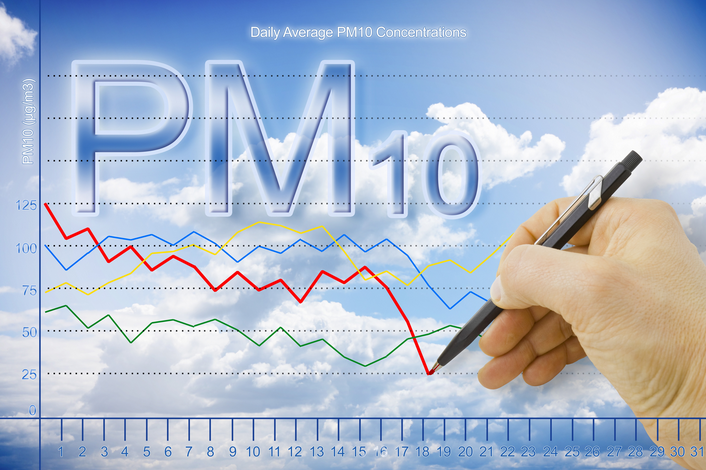- Alberto Gabrieli
- Original Article
Emergency Medical Service (EMS) calls as a sensitive index of short-term pollutant effects on human health: a retrospective study
- 2/2019-giugno
- ISSN 2532-1285
- https://doi.org/10.23832/ITJEM.2019.018

Abstract
Keywords
Environment and Public Health, Particulate Matter, Environmental Pollution, Emergency Medical Services, Emergency Medical Dispatch
Introduction
Air pollution is a growing problem in all industrially developed countries and its impact on human health has become an important research topic in recent years. Pollutants with demonstrated impacts on human health include gases and particulate suspensions. These particles (either in suspension, fluid or in solid state), are of varying composition and size and are sometimes referred to as aerosols. They are often catalogued as ‘floating dust’, but are best known as particulate matter (PM). This floating dust is most often categorised according to its aerodynamic diameter. The aerodynamic diameter is the diameter of a sphere-shaped particle that shows the same behaviour in the atmosphere as a dust particle. In the framework of air quality problems, particulate matter (PM) is the most important. Particulate matters such as PM10 and PM2.5 are defined as the fraction of particles with an aerodynamic diameter smaller than respectively 10 and 2.5 micrometres (μm)2,3. These pollutants are most consistently associated with a variety of health risks, ranging from acute symptoms, morbidity and premature mortality to a range of long-term effects. These effects extend to children and adults and to a large number of particularly susceptible groups within the general population such as those already suffering from respiratory, cardiovascular and cardiac problems4.
Methods
Results
|
Age (y), mean (±SD) |
63.3 (±24.7) |
|
|
Sex, male |
19957 (47.0) |
|
|
Severity degree |
White Code |
335 (0.8) |
|
Green Code |
11808 (27.8) |
|
|
Yellow Code |
24018 (56.5) |
|
|
Red Code |
6328 (14.9) |
|
|
Pathology |
Cardiovascular |
7895 (18.6) |
|
Respiratory |
4602 (10.8) |
|
|
Neurologic |
3965 (9.3) |
|
|
Psychiatric |
1467 (3.5) |
|
|
Traumatic |
11532 (27.1) |
|
|
Other |
13028 (30.7) |
|
|
Data are reported as numbers (%) unless otherwise noted. |
||
|
|
|||||||||||||||||||||||||||||||||||||||||||||||||||||||
Figure 1. Correlation between levels of PM10-PM2.5 and total emergency calls
This evidence is stronger for cardiovascular pathologies (r=0.0116 and p=0.0036 for PM10, r=0.0167 and p=0.0006 for PM2.5) as shown in Figure 2, and mostly for respiratory pathologies (r=0.0421 and p<0.0001 for PM10, r=0.0623 and p<0.0001 for PM2.5) as shown in Figure 3. In this study we found no correlation between PM levels and other pathologies.
Discussion
References
- The Relationship between Air Pollution and Emergency Room Visits in an Industrial Community; Jonathan M. Samet , Frank E. Speizer , Yvonne Bishop , John D. Spengler & Benjamin G. Ferris Jr; Journal of the Air Pollution Control Association, 19 February 2017
- Epidemiological time series studies of PM2,5 and Daily mortality and Hopital admission: a sistematic review and meta analysis; Atkison RW, Kang S, Anderson HR et al; Thorax 2014
- The impact of PM2.5 on the human respiratory system; Yu-Fei Xing, Yue-Hua Xu, Min-, Hua Shi, and Ti-Xin Lian;the Journal of Thoracic Disease; 2016 Jan; 8(1): E69–E74
- Ambient PM2.5 and risk of emergency room visits for myocardial infarction: impact of regional PM2.5 oxidative potential: a case-crossover study; Scott Weichenthal, Eric Lavigne, Greg Evans, Krystal Pollitt and RickT Burnett; Environmental Health 2016.
- Martuzzi, M., Mitis, M., Iavarone, I., Serinelli, M. (2006). Health impact of PM10 and ozone in 13 Italian cities: WHO Europe.
- Ambient Air Pollution and Respiratory Emergency Department Visits; Jennifer L. Peel, Paige E. Tolbert, Mitchel Klein, Kristi Busico Metzger, W. Dana Flanders, Knox Todd, James A. Mulholland, P. Barry Ryan, and Howard Frumkin; Epidemiology, 2005 March, Volume 16, Number 2
- Fine Particulate Air Pollution and Hospital Emergency Room Visits for Respiratory Disease in Urban Areasin Beijing, China; Qin Xu, Xia Li, Shuo Wan, Chao Wang, Fangfang Huang, Qi Gao, Lijuan Wu, Lixin Tao, Jin Guo, Wei Wang, Xiuhua Guo; PLOS ONE, April 2016.
- Air pollution and Emergency Room Visits for Asthma in Santa Clara County, California; M. Lipsett, S. Hurley, and Bart Ostro; Enviromental Health Perspectives, Volume 105,Number 2, February 1997.
- Air Quality and Pediatric Emergency Room Visits for Asthma in Atlanta, Georgia; Paig E.Tolbert, James A. Mulholland, David L. Macintosh, Fan Xu, Danni Daniels, Owen J Devine, Bradley P. Carlin, Mitchel Klein, Jenny Dorley, Andre J Butler, Dale F Nordenberg, Howard Frumkin, P. Barry Ryan and Mary C White; American Journal of Epidemiology 2000.
- Fine Particulate Matterand Emergency Room Visits for Respiratory Illness Effect Modification by Oxidative Potential; Scott A. Weichenthal, Eric Lavigne, Greg J. Evans, Krystal J. Godri Pollitt and Richard T. Burnett; American Journal of Respiratory and Critical Care Medicine, Volume 194, Number 5.
- Urban air pollution and Asthma and COPD hospital Emergency Room visits; Jaana I Halonen, Timo Lanki, Tarja Yli-Tuomi, Markku Kulmala, Pekka Tiittanen, Juha, Pekkanen; Thorax Online First, February 2011




